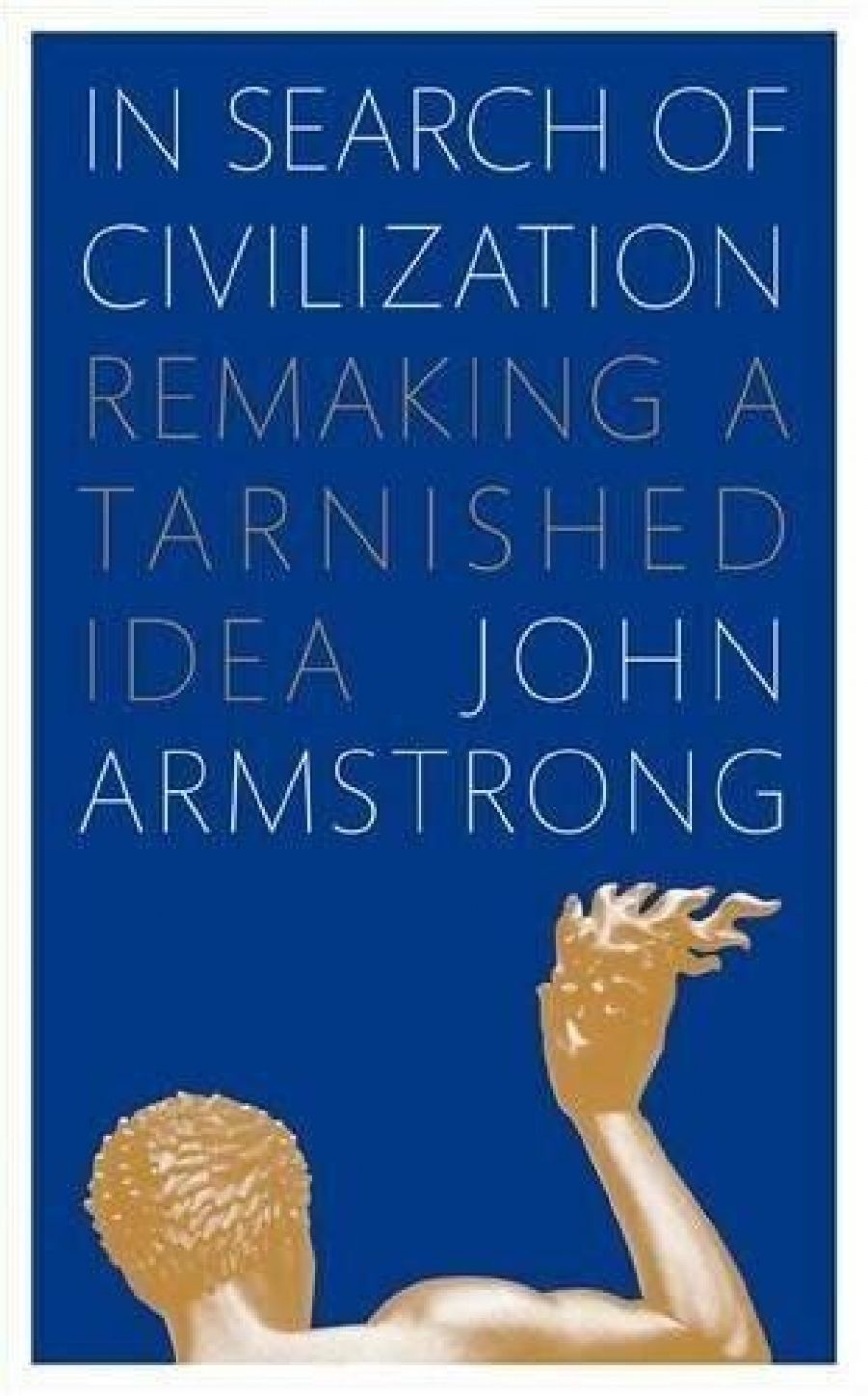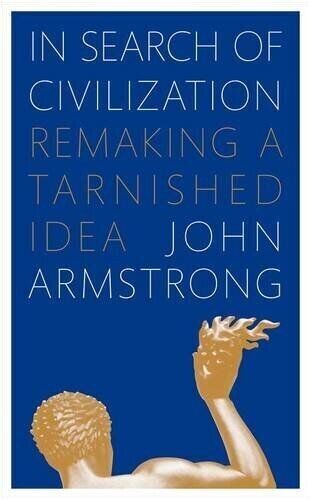
- Free Article: No
- Contents Category: Philosophy
- Review Article: Yes
- Article Title: Sweetness and light
- Online Only: No
- Custom Highlight Text:
John Armstrong hails from Scotland and is currently philosopher in residence at the Melbourne Business School. He is well known for several popular but elegant works on, broadly speaking, aesthetic matters: among them, Conditions of Love (2002), The Secret Power of Beauty (2004) and Love, Life, Goethe (2006). His recent book is more ambitious than its predecessors, but remains essentially in their fold.
- Book 1 Title: In Search of Civilization
- Book 1 Subtitle: Remaking a tarnished idea
- Book 1 Biblio: Allen Lane, $35 pb, 210 pp, 9781846140037
- Book 1 Cover Small (400 x 600):

- Book 1 Cover (800 x 1200):

The book is in many ways admirable, but not for philosophical virtues. Viewed in a philosophical light, it does not shine. Its arguments are thin and often unpersuasive, and there is little of the precision and rigour that delight philosophers. Many vexing philosophical issues aroused by its explorations are simply skirted. Armstrong has fiercely held views about the outward architecture of civilisation, about which things are beautiful, good and true, fine, kind and noble, but he largely neglects analysis of the master concepts (what does ‘beautiful’ mean?), and the empirical reasons why objects fall under them (why are these things beautiful?). There are limits to what can be learned about civilisation, and thus to determining what we ought to think it is, without careful conceptual analysis and appeal to the sciences – psychology, sociology, economics – resources that Armstrong ignores.
Civilisations are often thought of as established ways of life informed by dominant values shared by substantial religious, linguistic or regional groups. But that traditional view is inadequate, Armstrong insists. Civilisation does not merely endorse what is; it aims at the best and most intelligent version of a particular tradition. That raises the question of what is best and, implicitly, the spectre of cultural relativism and ‘the clash of civilisations’. Armstrong’s reaction to the spectre is too swift. ‘The rich accomplishments of China, Islam or the West are not really in desperate conflict … What is best in each civilization has much in common; more in common, in fact, than with degraded versions of itself.’
The arguments for this commonality turn weakly on the achievement of religious harmony in Scotland and the observations of a couple of refined, oriental travellers. Africa is unnoticed. Armstrong’s view is from atop high culture, ‘the greatest imaginative and creative effort’ we know. The deepest foundations of civilisation, he says, are located in the arts and humanities. Civilisation, it seems, is the House of Beauty, Truth and Goodness, but mostly of Beauty.
The remote influence is Plato, but the proximate one is Mathew Arnold. They share a perfectionist, absolute conception of value. The best is the same for all humankind. ‘Culture has one great passion, the passion for sweetness and light’, Arnold wrote in Culture and Anarchy. We must have thought, ‘sensible to beauty, intelligent and alive. Only it must be real thought and real beauty; real sweetness and real light.’ Armstrong embraces the theme. Civilisation shapes and directs our longings and shows us what is valuable. It fosters and protects those qualities in us that enable us to love these things: ‘The qualities that inspire love are goodness, beauty and truth. And when we love these qualities we come to possess the corresponding capacities of wisdom, kindness and taste.’ So civilisation is ‘the life-support system for high quality relationships to people, ideas and objects’. And the values informing high-quality relationships are not the slaves of time or fashion. ‘We have to forget the shifting patterns of fashion. Something is good because it is good, not because it was created yesterday or five hundred years ago.’ I would not lightly deprecate these thoughts, though argument would appeal more than tautology.
However, there is another view, rife amongst ‘barbarians’, the materially rich but spiritually poor. According to it, civilisation is just a high level of material prosperity or, at best, a web spun from it. Armstrong rejects the equation of civilisation and material prosperity: civilisation is material prosperity plus prosperity of soul, which consists in sweetness and light, wisdom and the appreciation of beauty. ‘Civilization occurs when a high degree of material prosperity and a high degree of spiritual prosperity come together and mutually enhance each other.’ But Armstrong is acutely conscious of the traditional, mutual hostility between material and spiritual prosperity. Beauty and goodness, money and the business of making it, have not got on. His insistence on their need for each other is thematically the most innovative feature of the book.
The charges are familiar: that many of the finest artistic achievements rose from the ground of vast material inequalities; that material prosperity erodes inner prosperity; that the barbarian outside the tower, and the one within us, despises beauty and sensibility; that money and goodness are irreconcilable. Armstrong thinks they can be sorted out. The drive to material accumulation, he argues, is unavoidable, but is not the problem. ‘The problem is not material expansion; it is material expansion in the absence of an equal degree of spiritual growth.’ Our spiritual condition has been damaged – and here he is thinking especially of the last half of the twentieth century – because the arts and humanities failed to guide and educate taste. The laurels were scattered recklessly. We lost our sense of what is beautiful, gracious and attractive.
The right response, Armstrong suggests, is not to disable the mechanisms of accumulation but to ‘concentrate on the task of supporting and diffusing wisdom, kindness and taste’. And so to the ‘the greatest question of our age: How can money and goodness work together to make us happy?’ Armstrong answers: ‘develop spiritual prosperity that can hold its own against the material drive.’ Unfortunately, apart from some improvised passages on business, where he explains that ‘we need being ethical and generous and noble and intelligent to be ways of making money’(sic), the practical application of these insights is left suspended in air.
What are we to make of this train of thought? It is a radical oversimplification of an immensely complex state of affairs. Materialism doesn’t look bad because of a want of decent art critics, and the idea that commercial voracity can be tamed with sweetness and light seems otherworldly to me. Besides, is the greatest conflict of the age really between money and goodness? Armstrong seems not to notice the violent religious, racial and nationalist passions sweeping the world, or the deep socio-economic currents that do most to shape it. At such points it is irresistible to accuse him, as Arnold was accused, of mincing through the slaughter on the battlefield, handing around his pouncet-box.
Moreover, Armstrong completely ignores science. It is not just that science is the ‘greatest creative and imaginative effort’ of modern times. Our understanding and experience of the world, including of ourselves and of art, have been radically transformed by it. It has spawned the technologies that shape our material Lebenswelt and has refined our conceptions of what constitutes rationality. The ways of science are defining motifs of contemporary civilisation. A study of civilisation that omits the impact of science is fatally defective.
But the book is not without great strengths. Armstrong has a fine eye and a rare capacity to describe aesthetic and cultural experience in language that is simple and often lovely. As a book of insights, appreciation and exhortation to embrace civilisation’s sweetness and light, In Search of Civilization is a considerable achievement. There are marvellous observations on the art of living, on tragedy, epic, barbarism, decadence and the civilising process. It largely succeeds in avoiding didacticism and condescension, though occasionally the effort appears exhausting. In many ways this is a personal book, and what the author has chosen to share with readers is presented with great charm. It is a significant contribution to a civilising mission which, as Armstrong says, begins with ‘trying to transmit what you love’.


Comments powered by CComment